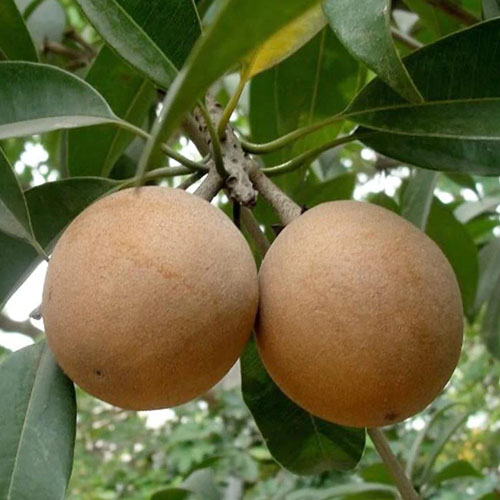Cricket Ball Sapota Plants
Cricket Ball Sapota, also known as Cricket Ball Chikoo or Cricket Ball Sapota, is a variety of sapota (Manilkara zapota) known for its distinctive fruit size and shape. Here’s a guide to this variety:
Characteristics of Cricket Ball Sapota Plants
-
Size and Growth Habit:
- Similar to other sapota varieties, Cricket Ball sapota trees are medium to large-sized, reaching heights of 30-60 feet (9-18 meters).
- They have a dense, rounded canopy with a spreading growth habit.
-
Leaves:
- The leaves are glossy, dark green, elliptical or ovate, about 4-6 inches (10-15 cm) long.
- They have a leathery texture and are arranged alternately on the stem.
-
Flowers:
- The flowers are small, greenish or yellowish, and typically clustered.
- They are inconspicuous compared to the fruit.
-
Fruit:
- The fruit is round and typically about the size of a cricket ball, hence the name.
- It has a rough, brown skin and a sweet, grainy flesh that is usually light brown or orange.
- Inside, the fruit contains several black or dark brown seeds.
-
Lifespan:
- Like other sapota varieties, Cricket Ball sapota trees can live and produce fruit for several decades, often starting to bear fruit within 4-5 years of planting.
Growing Conditions
-
Climate:
- Cricket Ball sapota thrives in tropical and subtropical climates with warm temperatures and high humidity.
- It is sensitive to frost and requires a frost-free environment.
-
Soil:
- Prefers well-draining, fertile soils. It grows best in sandy loam or loamy soils with a slightly acidic to neutral pH (pH 6.0-7.5).
- Good drainage is essential to prevent root rot.
-
Sunlight:
- Full sun is crucial for Cricket Ball sapota. It needs at least 6-8 hours of direct sunlight per day.
-
Watering:
- Regular watering is important, especially during dry periods. Sapota prefers consistent moisture but should not be waterlogged.
- Drip irrigation is often used to maintain even soil moisture.
Care Requirements
-
Pruning:
- Prune the tree to maintain its shape, remove dead or diseased branches, and improve air circulation.
- Pruning is best done in late winter or early spring.
-
Fertilization:
- Apply a balanced fertilizer or one specifically formulated for fruit trees periodically.
- Fertilize in early spring and during the growing season to support healthy growth and fruiting.
-
Pest and Disease Management:
- Watch out for pests like fruit flies, aphids, and scale insects, as well as diseases like leaf spot and root rot.
- Implement integrated pest management (IPM) practices.
-
Mulching:
- Use mulch to retain soil moisture, suppress weeds, and regulate soil temperature.
- Keep the mulch a few inches away from the trunk.
-
Harvesting:
- Harvest the fruit when it is fully ripe and has developed its characteristic color and softness.
- The fruit should yield slightly to pressure when ripe. Store harvested fruit in a cool, dry place or refrigerate.


